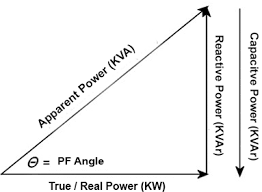Power factor is a measure of the efficiency of electrical power utilization in an AC (alternating current) circuit. It is the ratio of the real power (active power) to the apparent power in the circuit. In an AC circuit, the power can be divided into two components: real power (P) and reactive power (Q). Real power represents the actual power consumed or transferred in the circuit, which performs useful work such as generating heat, light, or mechanical work. Reactive power represents the power oscillations between the source and reactive elements (inductive or capacitive) in the circuit, which do not perform any useful work but contribute to voltage and current phase differences.
Power Factor Calculator
The power factor (PF) is defined as the ratio of real power (P) to the apparent power (S) in the circuit:
Power Factor (PF) = P / S
where P is the real power and S is the apparent power.
Apparent power (S) is the product of the voltage (V) and current (I) in the circuit:
S = V * I
Power factor can also be expressed in terms of the cosine of the angle (θ) between the voltage and current waveforms, known as the phase angle:
PF = cos(θ)
A power factor of 1 (or unity power factor) indicates that the real power is equal to the apparent power, meaning the circuit is using power efficiently with no wasteful reactive power. In this case, the voltage and current waveforms are in phase, and there is no phase difference between them.

A power factor less than 1 indicates that there is reactive power in the circuit, causing a phase difference between voltage and current. This occurs when the circuit contains inductive or capacitive elements, such as motors, transformers, or fluorescent lights. The power factor can be improved by adding power factor correction capacitors or reactors to the circuit, which helps reduce the reactive power and bring the power factor closer to unity.
A low power factor leads to inefficient power utilization, increased losses, and higher electricity bills. Utilities often charge penalties for low power factor as it places a burden on the power distribution system.
Therefore, maintaining a high power factor is desirable to ensure efficient utilization of electrical power and minimize reactive power in AC circuits.
Power Factor (PF) = P / (V * I)
where: PF is the power factor P is the real power (in watts) V is the voltage (in volts) I is the current (in amperes)
To use this calculator, you’ll need the values of real power (P), voltage (V), and current (I) in your AC circuit.
Let’s say you have the following values: Real power (P) = 1000 watts Voltage (V) = 120 volts Current (I) = 5 amperes
Using the formula, we can calculate the power factor as follows:
PF = 1000 / (120 * 5) = 1000 / 600 = 1.67
In this example, the power factor is approximately 1.67.
Remember that power factor is a dimensionless value ranging from 0 to 1, and a power factor of 1 indicates unity power factor, which is the most efficient power utilization.
Keep in mind that this is a basic calculator assuming a simple circuit. In practical applications, power factor calculations can involve more complex factors, such as reactive power, phase angles, and power factor correction. If you have a more complex circuit or need a more accurate calculation, it’s advisable to consult an electrical engineer or use specialized software or tools for power factor analysis.